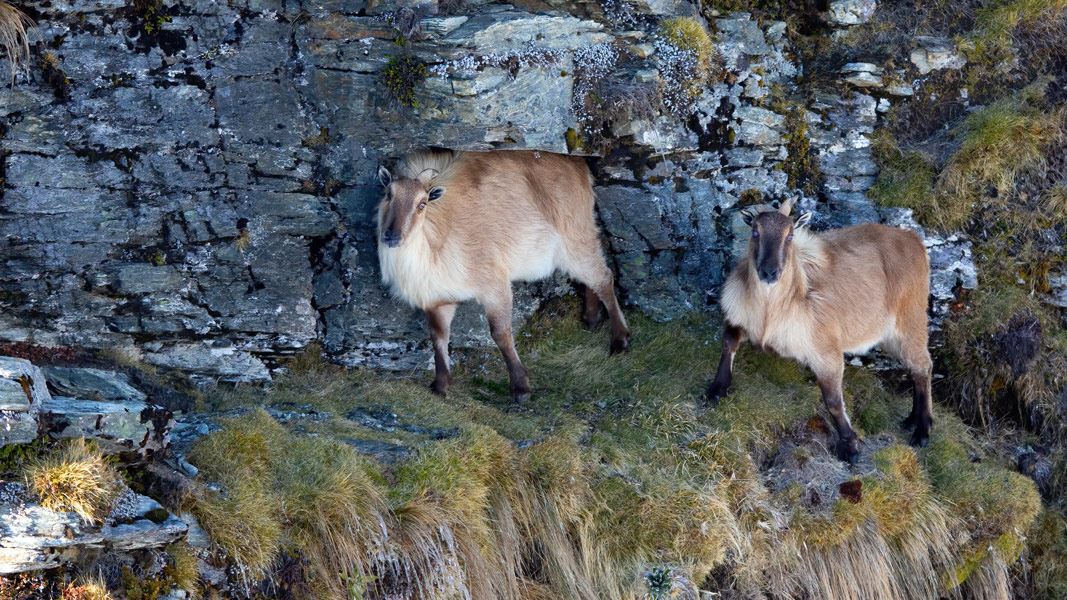Where to hunt tahr
Tahr often graze at high altitudes on alpine grasslands and sub-alpine shrublands. This includes on public conservation land, private land, and Crown pastoral leases. Their feral range spans the Southern Alps from the headwaters of Canterbury's Rakaia River to the Young Range of Otago.
DOC maps the locations of tahr observed on public conservation land which you can use to plan a hunt. You can browse our hunting blocks in these areas:
Find hunting blocks in:
Hunting seasons and ballots for aerial access
Tahr can be hunted year-round. However, there are restrictions around aerial access to some areas:
When to hunt
Time of day
Tahr move around to rest and feed during regular periods of the day. Generally, they rest during the middle of the day, often amongst rocky outcrops well above the line of denser forest and bush.
They then descend to their feeding areas in the mid to late afternoon. During the evening, they come to the lower levels. After which they return to their resting sites higher up.
Dense areas with regular helicopter hunting
In dense areas of vegetation on the West Coast tahr behave differently.
Instead of resting and sheltering above the forest and bush line, they do so below it. They then feed upward into favoured tussock areas or onto open slips in the evening. Tahr will return to cover in the early morning.
Season
Late Autumn and Winter hunting
Winter is the most difficult time of year to hunt tahr, with the climate and day length working against you. However, if you want to find a bull in the best condition, then there is no substitute for the rut which runs from May to mid-July. During this time, bulls have a prized thick, reddish to dark brown pelt.
Three groupings come together around April–May before the rut. The first group consists of females, kids, and juvenile males. The second group are mature bulls over 4 years old and the third is made up of immature bulls around 2–3 years.
The rut then occurs from late May to mid-July. At that time, the mature bulls mix with the female group and stay if there is a female in oestrus. Bulls competing for the same female can enter prolonged displays which rarely end in fighting.
Spring hunting
In springtime, tahr are coming out of their winter coat. They are a lot lighter in colour and easier to spot. Tahr also descend to low to mid altitudes this time of year, meaning you don't have to climb so long or high to hunt them.
Tips for hunting tahr
Firearms, ammunition and other equipment
For optimal results, use a flat trajectory calibre with high striking energy.
Equip your rifle with a strong sling so you can use both hands as necessary when walking. Use a spotting scope if you have one, but if not, take a pair of good binoculars instead.
You will be in a mountain environment so dress and be equipped accordingly. Good footwear is essential, ice axe and crampons are recommended for winter hunting in alpine terrain.
Approach and targeting
By sitting at a vantage point to observe a wide area, it can be easier to spot a trophy animal. When spotting over an area do not just look once, leave it a while and look again as animals may have been under cover the first time.
Tahr are often difficult to approach closely and can be in separate groupings all over a cliff face. They have a good sense of smell and hearing, and excellent eyesight. On approach, take advantage of as much cover as possible while moving into the wind to make it harder for the animals to smell you.
Bull tahr are difficult to put down once disturbed or if your shot placement is not perfect. Once you have selected your target, aim your shot to effectively hit the vital area of the animal. You should also prepare for a quick follow up shot to achieve a clean kill.
International travel with hunting trophies
You may need CITES documentation to enter or leave New Zealand with your hunting trophy.
